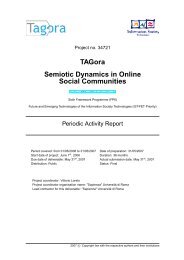NoiseTube: Measuring and mapping noise pollution with mobile ...
NoiseTube: Measuring and mapping noise pollution with mobile ...
NoiseTube: Measuring and mapping noise pollution with mobile ...
You also want an ePaper? Increase the reach of your titles
YUMPU automatically turns print PDFs into web optimized ePapers that Google loves.
well-identified <strong>noise</strong> <strong>pollution</strong> problems, such as in communities close to<br />
airports) to gather credible data.<br />
3.3.2 Social translucence mechanism<br />
<strong>NoiseTube</strong> uses the concept of social translucence consisting in making<br />
participants <strong>and</strong> their activities visible to one another. The role of social<br />
translucence is to inform, to create awareness <strong>and</strong> to enforce accountability<br />
[10]. These mechanisms also influence the level of the motivation of the<br />
individual <strong>and</strong> the group via social stimulation happening via social comparison<br />
[15], by reinforcing the perception of self-efficacy in a social context<br />
[1] or by displaying the value of contribution [25]. As pointed out in<br />
[6] despite the individual use of popular Web 2.0 services, such as<br />
Wikipedia <strong>and</strong> YouTube, opportunistic cooperation emerges among individuals<br />
due to interactions (e.g. comments) created by the visibility of their<br />
personal productions. Thus by making individual <strong>noise</strong> exposure public we<br />
intended to create opportunities to forge new relations among people facing<br />
to similar problems, which can then result it collective action, overcoming<br />
the cold start effect.<br />
3.3.3 Unconstrained participation<br />
Even though the ubiquity of <strong>mobile</strong> phones makes mass participation feasible,<br />
as attempted in [5, 20], it remains questionable how the general public<br />
can be motivated to voluntary do so. How to involve the hidden majority<br />
of citizens who do not participate in local organizations <strong>and</strong> want to use<br />
such technology for personal purposes? In our <strong>noise</strong> <strong>pollution</strong> context, the<br />
goal is to not force people to make their measures public <strong>and</strong> thus to always<br />
contribute at to a collective <strong>mapping</strong> process. By allowing users to<br />
choose if they want to share or not all or a part of their measurements, we<br />
also want to avoid privacy concerns.<br />
4. <strong>NoiseTube</strong> platform<br />
The current prototype of the <strong>NoiseTube</strong> platform consists of an application<br />
which the participants must install on their <strong>mobile</strong> phone to turn it into a<br />
<strong>noise</strong> sensor device. The <strong>mobile</strong> sensing application runs on GPS-equipped<br />
<strong>mobile</strong> phones. This application collects local information from different<br />
sensors (<strong>noise</strong>, GPS coordinates, time, user input) <strong>and</strong> sends it to the<br />
<strong>NoiseTube</strong> server, where the data is centralised <strong>and</strong> processed.




